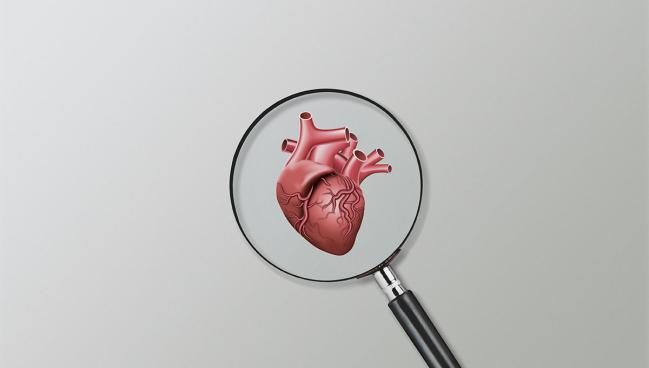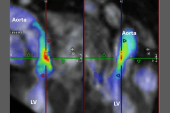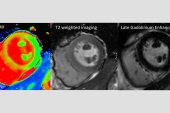CMR May Improve Assessment of ICD Need in Cardiac Sarcoidosis
The imaging was better than societal recommendations at discriminating long-term risk of ventricular arrhythmias.

Cardiovascular magnetic resonance (CMR) imaging may help physicians make decisions about which patients with suspected cardiac sarcoidosis require an implantable cardioverter-defibrillator (ICD) to prevent fatal or life-threatening ventricular arrhythmias, a new analysis suggests.
Among patients with histology-supported sarcoidosis and suspected cardiac involvement, CMR phenotyping better predicted 5- and 10-year risks of ventricular arrhythmia outcomes than criteria laid out in guidance from US and European professional societies, lead author Harold Mathijssen, MD (St. Antonius Hospital, Nieuwegein, the Netherlands), and colleagues report in a study published online recently in the European Heart Journal.
“CMR phenotyping can be used immediately in clinical practice to identify patients with suspected cardiac sarcoidosis who would benefit from a primary prevention ICD,” senior author Chetan Shenoy, MD (University of Minnesota Medical School, Minneapolis), told TCTMD via email.
“While this is a retrospective observational study and not a randomized clinical trial, there are no randomized data in cardiac sarcoidosis and the current societal recommendations are based on small, single-center studies and expert opinions (mostly level of evidence C-LD or C-EO),” he said. “Our large, multicenter, observational study provides better data (level of evidence B-NR),”
Current societal recommendations around the use of primary prevention ICDs—a 2014 expert consensus statement from the Heart Rhythm Society (HRS), 2017 guidelines from the American Heart Association, the American College of Cardiology, and the HRS, and 2022 guidelines from the European Society of Cardiology—are meant to be used in patients who have diagnosed cardiac sarcoidosis, Shenoy noted. However, making that diagnosis is tricky, with disagreement and inconsistency across multiple sets of criteria, he said.
“So, we need a risk-stratification strategy that does not involve making a diagnosis of cardiac sarcoidosis,” Shenoy argued.
The investigators compared CMR phenotyping with societal recommendations to assess their accuracy for predicting long-term risks of fatal and life-threatening ventricular arrhythmia outcomes. The analysis included 1,514 patients (median age 54 years; 54% men) with suspected cardiac sarcoidosis who underwent CMR with late gadolinium enhancement (LGE) imaging at three centers—one in the Netherlands and two in the United States. All patients were ineligible for a secondary prevention ICD. The most common clinical symptoms in this cohort were dyspnea (60%), palpitations (37%), and chest pain (26%).
Patients were divided into four CMR phenotypes:
- No LGE and normal LVEF
- No LGE and abnormal LVEF
- Pathology-frequent LGE (meaning it was accompanied by one of four features: subepicardial, multifocal, septal, or RV free wall involvement)
- Pathology-rare LGE (not accompanied by any of the four features)
Patients with pathology-frequent LGE (18% of the cohort) were deemed to have a high enough risk to warrant an ICD, whereas those in the other three groups were considered to lack a class I or IIa ICD indication. In comparison, 13.8% to 37.1% of patients would have been eligible for an ICD using the various sets of societal recommendations.
During a median follow-up of 4.5 years (maximum 10 years), 84 patients had a fatal or life-threatening ventricular arrhythmia. The high-risk CMR phenotype was associated with the highest 5- and 10-year rates—24.0% and 35.0%, respectively. Corresponding rates among patients deemed eligible for an ICD according to societal criteria were 12.6% to 22.7% at 5 years and 19.3% to 34.2% at 10 years.
The rates of ventricular arrhythmias among patients who were not eligible for a primary prevention ICD according to CMR imaging were 0.7% at 5 years and 2.6% at 10 years, with corresponding rates of 0.5% to 2.6% and 2.1% to 5.5%, respectively, in ICD-ineligible patients according to societal recommendations.
In terms of discriminative accuracy, CMR phenotyping was better than the societal criteria, with a time-dependent area under the receiver operating characteristic curve (AUC) of 0.861 (versus 0.712 to 0.813) for 5-year outcomes and 0.776 (versus 0.630 to 0.743) for 10-year outcomes.
Moreover, CMR phenotyping had the strongest association with ventricular outcomes on multivariable analysis (subdistribution HR 19.8; 95% CI 10.9-36.0).
Shenoy said CMR phenotyping is superior to societal recommendations for multiple reasons, including that it does not require making a diagnosis of cardiac sarcoidosis. Additionally, it requires only one test (CMR) rather a combination of tests and involves a visual assessment of LGE patterns, “which can be done in seconds and does not need any specialized software or quantification,” he specified.
It also has a physiological basis, Shenoy said, noting that “the CMR patterns were derived from a prior systematic study from our group where we examined gross pathology photographs of the hearts of patients with cardiac histology-supported cardiac sarcoidosis who underwent heart transplantation or had died suddenly.”
Though every center with CMR capabilities can perform the assessments done in this study, such imaging is not available at every center that manages patients with sarcoidosis, Shenoy said. “Cardiac sarcoidosis is a rare disease that requires expertise for diagnosis and management, so if it is suspected, patients should be referred to one of the centers with specialized sarcoidosis programs, and they can do CMR and CMR phenotyping.”
Regarding next research steps, Shenoy noted that only 20% of patients in this study were nonwhite. “Sarcoidosis is prevalent in African Americans, and replication of our findings in larger cohorts of nonwhite patients would be helpful,” he said.
Todd Neale is the Associate News Editor for TCTMD and a Senior Medical Journalist. He got his start in journalism at …
Read Full BioSources
Mathijssen H, Bawaskar PH, Rochlani Y, et al. Prediction of ventricular arrhythmic outcomes in suspected cardiac sarcoidosis: a comparison of cardiovascular magnetic resonance phenotyping vs societal recommendations for implantable cardioverter-defibrillator placement. Eur Heart J. 2025;Epub ahead of print.
Disclosures
- Shenoy reports being supported by grants from the National Institutes of Health (NIH), a University of Minnesota Clinical and Translational Science Institute KL2 Scholars Career Development Program Award (NIH grant KL2TR000113-05), and a University of Minnesota Clinical and Translational Science Institute K-R01 Transition to Independence Grant (supported by NIH grant UL1TR002494). He also has served as a consultant for Medtronic and Lexeo Therapeutics.
- Mathijssen reports no relevant conflicts of interest.





Comments